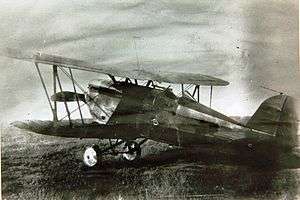Heinkel HD 37
| HD 37, I-7 | |
|---|---|
 | |
| Heinkel HD 37 | |
| Role | Fighter |
| National origin | Germany |
| Manufacturer | Heinkel, TsKB |
| First flight | 1928 |
| Primary user | Soviet Air Force |
| Number built | 134+ |
|
| |
The Heinkel HD 37 was a fighter aircraft designed in Germany in the late 1920s, but produced in the USSR for Soviet Air Force service. It was a compact, single-bay biplane with staggered wings of unequal span braced by N-type interplane struts. The pilot sat in an open cockpit and the main units of the tailskid undercarriage were linked by a cross-axle.
Design and development
It had been designed for the clandestine air force that the Reichswehr was training at Lipetsk, but had been rejected by German officials, who purchased the Fokker D.XIII instead.
Fortuitously for Heinkel, the Soviet Air Force was experiencing a crisis with the obsolescence of its main fighter, the Polikarpov I-5 and with no replacement apparently forthcoming from domestic manufacturers. When Heinkel was approached to provide an alternative, the firm was able to offer the HD 37, and the two prototypes were flown to Moscow in early 1928. Flight testing produced mixed results. While the basic design was apparently sound, Soviet test pilots reported many deficiencies in handling, and Heinkel was presented with a long list of complex changes to be made. Heinkel responded with the HD 43, and when the same Soviet test pilots found that they liked it even less than the HD 37, attention shifted once again to the previous design by the end of 1929. Early the following year, the Soviet government bought a licence to manufacture the type for the next three years, paying Heinkel 150,000 Marks for it. Manufacturing was to be carried out by TsKB, and the designation I-7 was assigned.
Many of the fixes that had been adopted in the creation of the HD 43 were eventually implemented in the I-7 as well, along with other modifications, and by the time the first examples flew in summer 1931, flight test results were positive. Despite ongoing difficulties in obtaining materials, 131 examples were produced by 1934. Most of these served briefly with units in Belarus, but by the time the last examples were leaving the factory, the type was already obsolescent.
Operators
Specifications (I-7)
General characteristics
- Crew: One pilot
- Length: 6.95 m (22 ft 10 in)
- Wingspan: 10.00 m (32 ft 10 in)
- Height: 3.20 m (10 ft 6 in)
- Wing area: 25.9 m2 (279 ft2)
- Empty weight: 1,419 kg (3,121 lb)
- Gross weight: 1,792 kg (3,942 lb)
- Powerplant: 1 × Mikulin M-17F, 540 kW (730 hp)
Performance
- Maximum speed: 291 km/h (182 mph)
- Range: 700 km (440 miles)
- Service ceiling: 7,200 m (23,600 ft)
- Rate of climb: 9.7 m/s (1,900 ft/min)
Armament
- 2 × fixed, forward-firing 7.62 mm (.30 in) PV-1 machine guns
References
| Wikimedia Commons has media related to Heinkel HD 37. |
- Taylor, Michael J. H. (1989). Jane's Encyclopedia of Aviation. London: Studio Editions. p. 499.